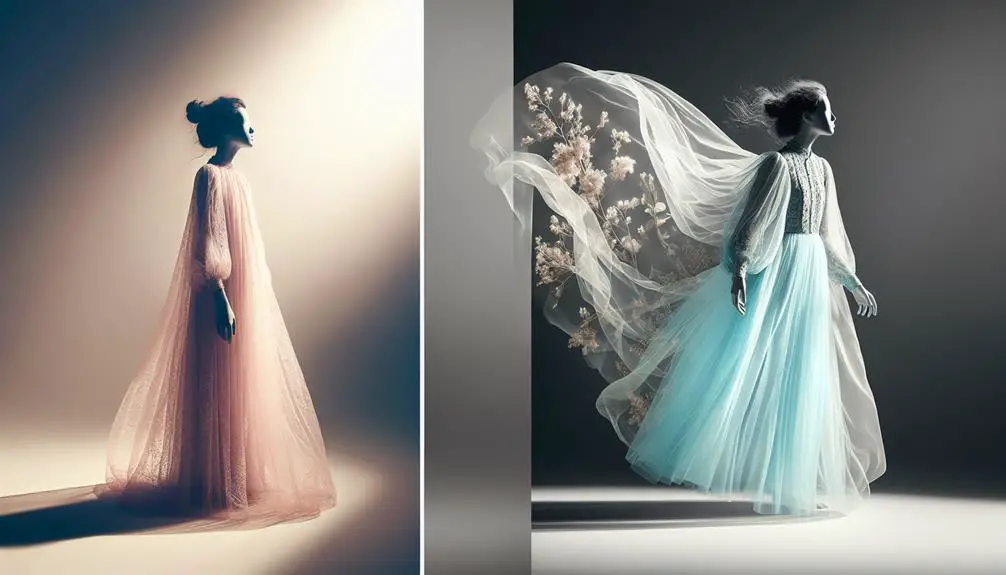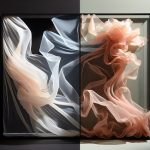Honestly, choosing between organza and chiffon really depends on what you're after. Organza's great if you want something with a bit more structure and volume, perfect for those standout, formal dresses. It holds its shape incredibly well, thanks to its stiffness, but it does need a bit of gentle handling. On the other hand, chiffon is your go-to for lighter, flowing garments. It's fantastic for effortlessly draping and moving with your body, giving a really elegant look and feel. Each fabric suits different needs and occasions—they both have their place in fashion. Guess it pays to know how each could revamp your wardrobe, right?
Table of Contents
Key Takeaways
- Organza is best for structured, voluminous garments like ball gowns due to its stiffness and ability to hold shape.
- Chiffon is ideal for flowy, elegant outfits, providing a graceful drape that moves with the body.
- Organza offers greater durability and tear resistance, making it suitable for more robust designs.
- Chiffon is generally more affordable and easier to maintain, often machine washable unlike organza.
- The choice between organza and chiffon depends on the desired garment function and aesthetic, with organza adding structure and chiffon offering softness.
Understanding Organza
Organza is a stiff, sheer fabric that's often used in formal wear and decorations. It's crafted from silk, though modern varieties might include synthetic fibers like polyester or nylon, which enhance durability and reduce cost. This fabric is known for its crisp drape, making it a favorite for creating voluminous skirts, structured dresses, and evening gowns that need to hold their shape.
I've found that organza's unique texture and sheen give it an ethereal quality, setting it apart in the world of textiles. It's not just the visual appeal; the feel of organza is distinctively smooth, yet it possesses a dry, slightly coarse texture that you don't find in many other fabrics. This combination makes it particularly effective for adding a touch of elegance and structure to any outfit.
Handling organza requires some care to maintain its signature crispness. It's susceptible to fraying, so finished edges are a must. When sewing, I always use French seams or binding techniques to keep the edges neat and prevent unraveling. Despite these challenges, the stunning, airy results are well worth the effort, especially when I see a finished piece come to life.
Exploring Chiffon
Now, let's talk about chiffon.
This fabric is known for its light, airy qualities, which make it a go-to for elegant, flowy designs in fashion.
We'll look at its properties and versatility to understand why it's favored in many styles.
Chiffon Fabric Properties
Chiffon's lightweight and sheer texture makes it a popular choice for elegant garments. I've found its airiness perfect for creating a graceful drape that flatters almost any body type. This fabric isn't just about looks, though; it's also surprisingly strong, thanks to the twisted fibers used in its weaving. It's a bit tricky to work with because of its slippery nature, but the results are often worth the effort.
Here's a quick table to summarize the key properties:
| Property | Description | Benefit |
|---|---|---|
| Sheerness | Highly transparent | Adds delicacy |
| Weight | Very light | Comfortable to wear |
| Durability | Resistant to tearing | Long-lasting |
| Maintenance | Requires careful handling | Preserves quality |
Understanding these properties helps in mastering the use of chiffon in your projects.
Chiffon Versatility in Fashion
I've discovered that chiffon's adaptability makes it a favorite for designers crafting everything from evening gowns to everyday blouses. Its sheer, flowing quality adds a touch of elegance and softness to any outfit, which is probably why it's so popular for bridal wear and summer dresses.
But it's not just about looks; chiffon is also incredibly practical. It's lightweight, making it perfect for layering without adding bulk. You can also dye it in any shade imaginable, which really opens up the possibilities for customization and creativity. Plus, it drapes beautifully, creating flattering silhouettes that work for just about any body type.
Honestly, it's no wonder chiffon is such a go-to fabric in the fashion world!
Textural Differences
Both organza and chiffon have unique textures that distinctly set them apart. Let's dive into what makes each stand out. Organza is crisp and sheer, with a stiffness that gives it a structured yet delicate look. It's not the kind of fabric that clings or flows; instead, it holds its shape, making it ideal for fuller skirts or dresses where you want some body and volume.
On the flip side, chiffon is the epitome of flow. It's light and airy, often used in layers to create a soft, ethereal effect. Unlike organza, chiffon drapes beautifully, hugging curves gently and cascading with ease. It's the go-to for garments that need to move gracefully, think ballet skirts or flowy evening dresses.
Texture-wise, organza feels slightly rougher due to its tight weave and the silk fibers it's often made from. Chiffon is smoother and almost slippery to the touch because of the finer threads and higher twist in its weaving process.
Comparison of Durability
Now, let's talk about how tough these fabrics are.
I'll look into which one—organza or chiffon—can handle more wear and tear.
We'll explore their fiber strength and see how they hold up over time.
Fiber Strength Analysis
When comparing the durability of organza and chiffon, it's clear that organza typically offers greater fiber strength. Organza, being a stiffer fabric made from silk or synthetic fibers like polyester, holds up better under stress. It's tightly woven, which contributes to its robustness.
On the other hand, chiffon is lighter and more delicate due to its fine threads and slightly looser weave. This makes chiffon less optimal when you're looking for something that needs to withstand a bit of pulling or weight.
In practical terms, if you need a fabric that'll hold its shape and resist tears during use, organza is your go-to. Chiffon, while beautiful, is just more susceptible to damage under equivalent conditions. This distinction is crucial for selecting the right material for specific applications.
Wear and Tear Resilience
Building on the discussion of fiber strength, let's examine how organza and chiffon hold up to wear and tear.
I've found that organza, with its stiffer and more structured form, generally outlasts chiffon in durability. This is mainly because organza's silk or synthetic fibers are woven in a plain weave, which is inherently stronger.
On the other hand, chiffon, made typically from silk or polyester, features a looser weave and a slight stretch, making it more susceptible to snags and tears.
If you're after longevity and a fabric that maintains its shape over time, I'd lean towards choosing organza for garments that will see a lot of use or need to hold their shape well.
Suitability for Clothing
Both organza and chiffon fabrics offer unique advantages when it comes to making different types of clothing. Let's break down what sets them apart and how they can best be utilized.
I've noticed that organza, with its stiffer texture, holds shapes beautifully. It's perfect for creating structured garments like ball gowns and wedding dresses where you want that standout silhouette. The crispness of organza also makes it ideal for layered skirts and sleeves that need to maintain form. However, it's not the best for anything requiring a lot of draping or flow.
On the other hand, chiffon is my go-to for flowy, ethereal pieces. Its lightness and slight stretch give it a dreamy quality, making it excellent for overlay on dresses or for delicate blouses and scarves. Chiffon drapes and moves with the body, offering an elegant and soft appearance that's hard to achieve with organza.
When choosing between the two, I think about the garment's function and desired aesthetic. If I need structure and volume, I lean towards organza. For garments that need to flutter and flow, chiffon is undoubtedly superior. Knowing the strengths of each fabric allows me to tailor my choices to the specific needs of my designs.
Use in Event Decor
Shifting our focus to event decor, organza and chiffon each bring their own flair to celebrations and settings. When I'm planning an event, the choice between these two fabrics often comes down to the desired aesthetic and practicality of the venue.
Organza, with its stiffer texture, offers a crispness that works beautifully for structured decorations like bows and draping that retains shape. It's particularly stunning when you need something that catches light in an airy, fairy-tale manner. On the other hand, chiffon is your go-to for that flowy, ethereal look. It's amazing for creating a soft, romantic ambiance—perfect for wedding backdrops or gentle drapes that flutter in a breeze.
Here's a quick table comparing their uses in different decor aspects:
| Feature | Organza | Chiffon |
|---|---|---|
| Texture | Crisp and sturdy | Soft and flowing |
| Light Play | Shimmery, light-reflective | Subtly diffuses light |
| Ideal For | Structured decor elements | Flowy, draped elements |
| Maintenance | Tolerates more handling | Requires gentle handling |
| Visual Impact | Bold, stands out | Delicate, blends in |
Choosing between organza and chiffon really depends on the event's theme and the practical needs of the setup. Each fabric can dramatically enhance the decor, but it's crucial to match the material to the mood you're aiming to create.
Cost Considerations
When it comes to picking between organza and chiffon, cost is a big factor.
We'll compare their price ranges, see if there are any perks to buying in bulk, and go over what it costs to keep them looking good.
Let's see which one gives you more bang for your buck!
Price Range Comparison
Considering cost, organza generally tends to be more expensive than chiffon due to its silk composition. When you're planning a project or shopping for fabric, this is a crucial bit to keep in mind. Organza's price can be a bit of a shock if you're budget-conscious. It's stiffer and has a sheen that drives its cost up, especially if you opt for silk organza rather than synthetic versions.
On the flip side, chiffon is usually lighter on the wallet. It's made from cotton, silk, or synthetic fibers, which can vary in price, but it remains more affordable than most silk-based organza. This makes chiffon a go-to for those who need elegance without a hefty price tag.
Bulk Purchase Discounts
While we've looked at individual pricing, let's also consider the savings when buying organza or chiffon in bulk. If you're planning a big project or maybe stocking up for future crafts, purchasing large quantities can significantly cut down your costs. Here's how both fabrics fare in bulk:
- Price Breaks: Both materials offer discounts when purchased in larger quantities. The more you buy, the less you pay per yard.
- Supplier Relationships: Building a relationship with suppliers can lead to better deals and exclusive offers.
- Shipping Costs: Often, bulk orders qualify for reduced or free shipping, which adds up.
- Event Planning: For large events like weddings, buying bulk ensures color and texture consistency across all decor.
These factors make bulk purchasing a savvy option.
Maintenance Expense Analysis
Let's dive into the cost of maintaining organza and chiffon, since upkeep can really impact your budget. When you're choosing between these two fabrics, it's not just the initial price tag you've got to think about. Maintenance costs over time can add up, influencing which fabric becomes the more economical choice.
| Feature | Organza | Chiffon |
|---|---|---|
| Washing | Dry clean only | Machine washable |
| Ironing | Low heat | Low heat |
| Durability | Less durable | More durable |
| Frequency | Less frequent wash | Frequent wash |
| Repair Costs | Higher | Lower |
Organza tends to require more delicate handling and pricier dry cleaning, whereas chiffon can often be machine washed. This makes chiffon generally less costly to maintain, especially if you're juggling a busy schedule.
Care and Maintenance
To keep your organza and chiffon garments looking their best, you should follow specific care guidelines. I've learned that proper maintenance not only extends their life but also ensures they look fabulous every time you wear them. Here's how I keep my delicate pieces in top-notch condition:
- Hand Wash Softly: Always opt for hand washing with a gentle detergent. Machine washing can be too harsh, leading to tears or snags in these delicate fabrics.
- Cool Water is Key: Use cold water to prevent shrinking and maintain the fabric's integrity. Hot water is a big no-no for these sensitive materials.
- Drip Dry: After washing, don't wring them out. Instead, hang them up and let them air dry. This method avoids wrinkles and keeps the fabric from stretching.
- Low Heat Ironing: If you must iron, set your iron on the lowest heat setting and use a pressing cloth to avoid direct contact with the fabric. This protects against heat damage and preserves the texture.
I've found that treating these fabrics with a bit of extra care makes a huge difference. By following these steps, you can keep your chiffon and organza looking as elegant and pristine as the day you bought them.
Seasonal Appropriateness
Caring for organza and chiffon properly ensures they're ready for any season, whether it's a breezy summer evening or a festive winter party. Let's delve into how each fabric fares across different seasons.
Organza, with its stiffer texture, tends to hold up well in cooler months. It doesn't cling to your body, making it a great choice for winter or fall layering. The crispness of organza adds a structured yet delicate touch under heavier garments without adding bulk. I find it particularly handy for those transitional seasons where you need a bit of flair without compromising on comfort.
Chiffon, on the other hand, is your go-to for warmer weather. Its lightness and breathability are unmatched, perfect for those hot summer days when you want something that feels like next to nothing. Chiffon's flowy nature catches even the subtlest breeze, offering a cooling effect that's much needed when the temperature rises. I've always appreciated how chiffon layers beautifully without weighing down, which is ideal for spring and summer gatherings.
Popular Uses in Fashion
Both organza and chiffon have carved out their niches in the fashion industry due to their distinct textures and aesthetic appeal. When I'm looking for fabrics for specific designs, I often turn to these two for their unique characteristics. Let's break down where each really shines in the fashion world:
- Wedding Gowns: Organza's stiffness and shimmer make it perfect for structured bridal wear. It holds shapes beautifully, adding that fairy-tale volume without the weight. Chiffon, on the other hand, is the go-to for those flowy, ethereal layers that give a gown a dreamy look.
- Evening Wear: Chiffon dresses are staples for evening events. Their lightness and graceful drape make them ideal for elegant, flowing evening gowns. Organza is often used as an overlay, adding a subtle luster and structure to sophisticated outfits.
- Accessories: Organza finds its way into various accessories like ribbons and bows because of its crisp texture. It's perfect for adding a touch of formality and intricacy.
- Scarves and Shawls: Chiffon is incredibly popular for making scarves and shawls, especially for summer evenings. Its breathability paired with its softness offers both comfort and style.
These fabrics, while sometimes interchangeable, have specific strengths that really cater to different aspects of fashion design.
Final Verdict: Organza Vs Chiffon
When deciding between organza and chiffon, it's crucial to consider their unique properties and how they align with your design needs. Both fabrics offer distinct advantages, but the choice ultimately boils down to the specific requirements of your project.
Organza is your go-to if you're after structure and a slight shimmer. Its stiffer drape makes it ideal for garments that need to hold their shape, like bridal wear and evening gowns. The crispness adds a touch of elegance and volume without the heaviness you might find in other fabrics.
On the other hand, chiffon is unbeatable for flowy, ethereal looks. It's lightweight and offers a beautiful, soft drape that clings gently to the body, perfect for breezy dresses and overlays. If your design calls for a fabric that moves gracefully and feels like a whisper against the skin, chiffon is likely your best bet.
Frequently Asked Questions
Can Organza or Chiffon Be Dyed to Match Specific Colors?
Absolutely, both fabrics can be transformed into a rainbow of colors to perfectly match any shade you need. I've successfully dyed them for various projects, achieving vibrant and precise results every time.
Are There Hypoallergenic Options for Organza or Chiffon?
Yes, there are hypoallergenic options available for both fabrics. I've found that specifically treated organza and silk chiffon are less likely to irritate sensitive skin. It's worth checking the fabric's treatment details.
How Does UV Exposure Affect Organza and Chiffon Fabrics?
UV exposure can weaken both organza and chiffon, causing them to fade and deteriorate faster. I'd recommend limiting their sun exposure to maintain their strength and vibrant color for longer periods.
Can Organza or Chiffon Be Recycled or Upcycled?
Can't we all be a bit greener? I've found both organza and chiffon can be upcycled creatively. They're transformed into beautiful art pieces or reused in other fashion projects quite effectively!
Do Organza and Chiffon Fabrics Have Any Environmental Impacts?
Yes, they do. Both organza and chiffon production can harm the environment, mainly due to water and chemical use in manufacturing. I'm exploring sustainable alternatives to reduce my fashion footprint.
- Kevlar Layers and Ballistic Stopping Power: Layering Tips - June 21, 2025
- Kevlar Skin-on-Frame Canoe Fabric: Lightweight Boating Solutions - June 21, 2025
- Kevlar SKW30 Sail Fabric: Durability in Marine Environments - June 21, 2025






